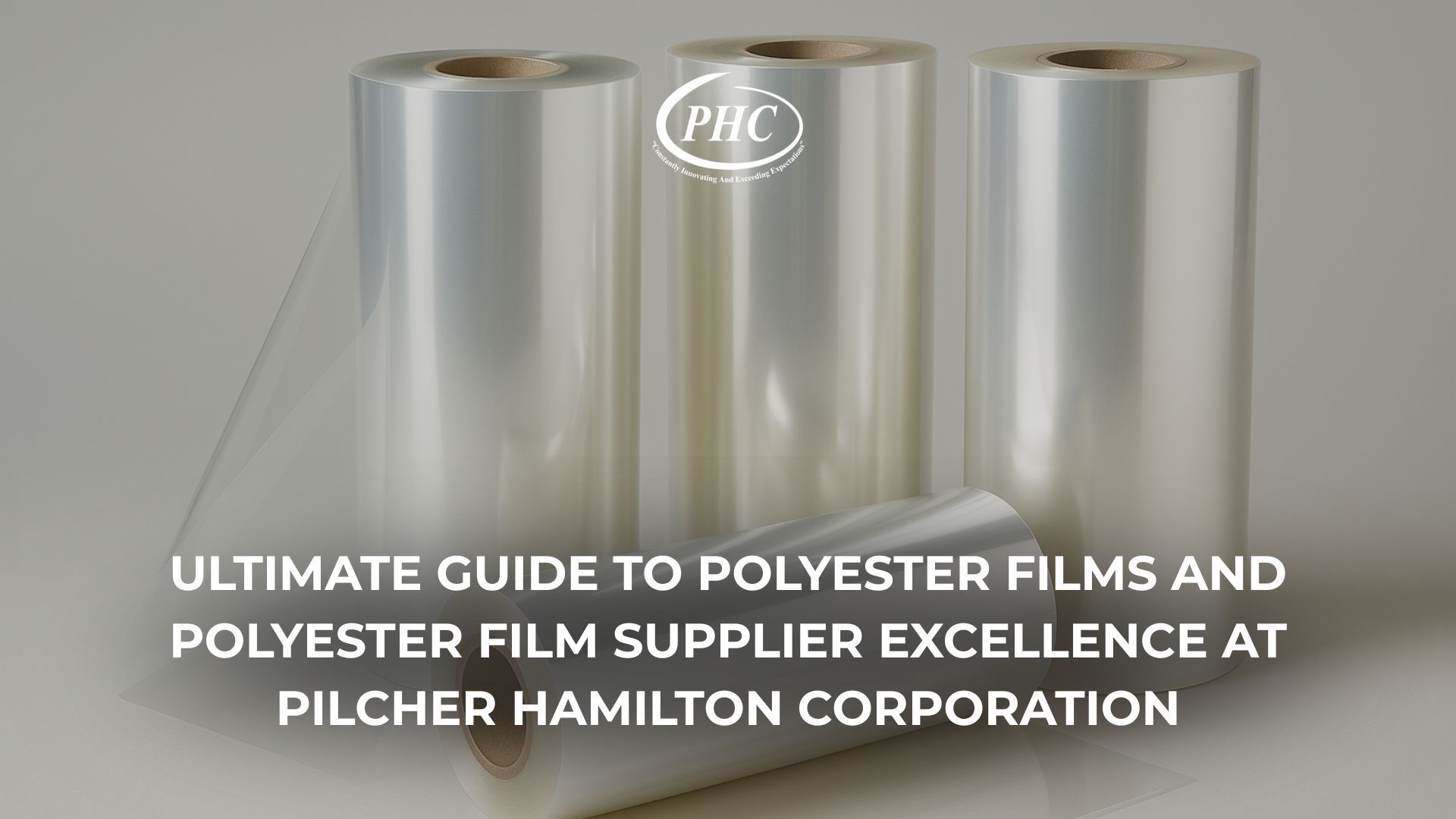- What are Polyester Films?: Polyester films are high-performance materials derived from polyethylene terephthalate (PET) resin, often biaxially oriented for enhanced strength, clarity, and barrier properties. They serve as versatile solutions in packaging, electrical insulation, and graphics industries.
- Why It Matters?: Polyester films provide exceptional mechanical durability, thermal resistance, and protection against oxygen, moisture, and contaminants. They support sustainable practices through recyclability and reduced material usage, contributing to eco-friendly innovations in various sectors.
- Who It’s For?: Engineers, procurement specialists, and operations managers in packaging, electrical, industrial, and graphic applications who require reliable, customizable films with rapid turnaround and U.S.-based expertise.
- Pilcher Hamilton Expertise: Established as the premier U.S. polyester film supplier since 1904, Pilcher Hamilton Corporation at 850 South Buncombe Road, Greer, South Carolina, delivers top-tier polyester films with advanced converting services for optimal results.
What Are Polyester Films and Their Core Properties?
Polyester films, primarily composed of polyethylene terephthalate (PET), stand as a pillar in modern material science. These films are created through a meticulous process where PET resin is extruded into a sheet, cooled, and then stretched in both the machine and transverse directions—a method known as biaxial orientation. This orientation aligns the polymer chains, resulting in a material that boasts superior mechanical, thermal, and barrier characteristics compared to non-oriented alternatives.
The production journey starts with high-purity PET pellets, which are melted at temperatures around 280-300°C and extruded through a die to form a flat amorphous sheet. Rapid cooling on a chill roll solidifies the structure, preventing crystallization. Subsequent heating to 80-120°C allows for stretching, typically at ratios of 3-4 times in each direction, followed by heat-setting at 200-240°C to stabilize the film. This process yields polyester films with gauges ranging from 6 to 350 microns, tailored for specific applications.
Core properties of polyester films include:
- Mechanical Excellence: With tensile strengths reaching 200-300 MPa and elongation at break of 80-150%, polyester films resist tearing, puncturing, and abrasion. Their high modulus (3-5 GPa) ensures rigidity, making them suitable for structural uses.
- Thermal Resilience: Polyester films maintain integrity from -70°C to 150°C, with a melting point near 260°C. This allows them to endure heat-sealing, sterilization, and high-temperature environments without deformation.
- Barrier Capabilities: Plain polyester films offer oxygen transmission rates (OTR) of 80-120 cc/m²/day and moisture vapor transmission rates (MVTR) of 15-25 g/m²/day. Enhanced versions, such as metallized or coated films, can drop these to under 1 unit, providing robust protection.
- Optical Superiority: Boasting light transmission over 90% and haze below 1%, polyester films deliver crystal-clear visibility, essential for display and graphic applications.
- Electrical Insulation: Featuring dielectric strengths of 150-250 kV/mm and volume resistivity exceeding 10^17 ohm-cm, they excel in insulating components like motors and capacitors.
- Chemical Inertness: Resistant to most acids, bases, and solvents, polyester films ensure longevity in harsh conditions.
At Pilcher Hamilton Corporation, recognized as the leading polyester film supplier in the U.S., we specialize in enhancing these properties through proprietary treatments. For example, our corona-treated polyester films achieve surface tensions of 42-58 dyne/cm, improving wettability for inks and adhesives. If you’re looking for “polyester near me,” our Greer, SC location ensures prompt access to these advanced materials.
Delving deeper, the molecular structure of polyester films—repeating units of ethylene glycol and terephthalic acid—contributes to their crystallinity (30-50% post-orientation), which bolsters barrier and thermal properties. Variations like amorphous PET (APET) offer thermoformability, while crystalline PET (CPET) provides higher heat resistance.
In terms of sustainability, modern polyester films incorporate post-consumer recycled (PCR) content, maintaining 95-100% of virgin material performance. Pilcher Hamilton pioneers this, offering PCR polyester films that reduce environmental impact without compromising quality.
Polyester film manufacturies, like ours, employ rigorous quality controls, including inline optical inspection to detect defects as small as 50 microns. This ensures consistency in properties across rolls.
For printability, chemical-treated polyester films from Pilcher Hamilton feature enhanced anchorage, preventing delamination in laminates. Our acrylic-coated grades support flexographic and digital printing with sharp, vibrant results.
Electrically, polyester films’ low dissipation factor (0.001-0.003 at 1 kHz) minimizes energy loss, making them ideal for high-frequency applications.
In packaging, their aroma retention preserves product freshness, crucial for food and beverages.
Pilcher Hamilton’s portfolio includes general-purpose industrial polyester films for tapes and labels, with COF adjustable from 0.3-0.6.
As a South Carolina polyester film supplier, we integrate local manufacturing advantages, reducing carbon footprints through shorter supply chains. Searching “polyester near me” connects businesses to our expertise.
Expanding on fabrication, polyester films can be slit to widths as narrow as 0.25 inches or sheeted to custom dimensions, all with clean edges to prevent dusting.
Technical datasheets from Pilcher Hamilton detail specifics like yield (square meters per kg) and density (1.4 g/cm³), aiding design decisions.
Polyester film manufacturies continue to innovate, with Pilcher Hamilton leading in U.S.-compliant, high-clarity graphic grades for signage.
Their versatility extends to medical uses, where biocompatibility and sterilizability shine.
In summary, the core properties of polyester films position them as indispensable, with Pilcher Hamilton as your trusted supplier.
Key Applications in Packaging, Electrical & Graphics
Polyester films’ adaptability shines across sectors, driven by their unique property profile.
In packaging:
- Flexible Packaging: Used as outer layers in laminates, polyester films provide print surfaces and barriers. For instance, metallized polyester films in coffee pouches block light and oxygen, extending shelf life by months.
- Food Contact: Anti-fog polyester films ensure clear visibility for refrigerated goods, with coatings that disperse water droplets instantly.
- Pharmaceutical: PVDC-coated polyester films protect sensitive drugs from moisture, meeting stringent FDA requirements.
- Industrial Wrapping: Heat-sealable polyester films enable secure seals in heavy-duty bags, with peel strengths tailored to 3-8 N/cm.
Electrical applications leverage insulation:
- Motor and Coil Insulation: UL-approved polyester films wrap wires, withstanding voltages up to 10 kV and temperatures to 130°C Class B.
- Capacitors and Transformers: Thin-gauge polyester films (6-12 µm) serve as dielectrics, offering low leakage and high breakdown strength.
- Flexible Printed Circuits: Corona-treated polyester films act as substrates, supporting copper adhesion for bendable electronics.
Graphics and printing:
- Labels and Decals: High-clarity polyester films accept UV and solvent inks, resisting fading for outdoor use.
- Overlays and Membranes: Silicone-coated release polyester films enable easy application in touch panels.
- Signage and Displays: Opaque white polyester films provide backlighting diffusion, with matte finishes reducing glare.
Pilcher Hamilton, the foremost polyester film supplier, optimizes these through precision slitting and coating. A client in packaging used our twistable clear metallized polyester films for confections, improving machinability and aesthetics.
For those querying “polyester near me,” our Greer facility delivers customized rolls swiftly.
Polyester film manufacturies produce specialized grades like biax-oriented nylon laminates for added toughness in graphics.
Benefits include reduced downtime via consistent quality, with Pilcher Hamilton’s QA ensuring <0.1% defect rates.
Case: An electrical manufacturer adopted our insulating polyester films, boosting efficiency 25% through better heat dissipation.
In pharma, our barrier polyester films complied with child-resistant standards.
Graphics clients praise our print-laminate polyester films for vibrant, durable outputs.
Our toll converting transforms stock polyester films into application-specific formats, with winding ensuring flat, tension-free rolls.
Sheeting services provide cut-to-size sheets for graphic presses, minimizing waste.
Polyester film manufacturies like Pilcher Hamilton integrate digital tracking for traceability.
Overall, these applications underscore polyester films’ indispensability.
Advantages Over Traditional Materials
Polyester films surpass alternatives in performance metrics, as shown in this comparison:
| Property | Polyester Films | PVC Films | Polyethylene Films | Paper | Aluminum Foil |
| Tensile Strength (MPa) | 200-300 | 40-80 | 10-40 | 20-50 | 50-100 |
| OTR (cc/m²/day) | 80-120 (plain), <1 (enhanced) | 100-300 | 2000-5000 | Very High | <0.1 |
| MVTR (g/m²/day) | 15-25 (plain), <1 (enhanced) | 20-60 | 5-20 | High | <0.1 |
| Temperature Range (°C) | -70 to 150 | -20 to 70 | -50 to 90 | Up to 100 | High |
| Recyclability | Excellent (#1 PET) | Fair | Good | Excellent | Good |
| Cost per Sq. M | Medium | Low | Low | Low | High |
| Environmental Footprint | Low with PCR | High (halogens) | Medium | Low | High mining impact |
Advantages:
- Vs. PVC: Polyester films avoid harmful additives, offering better eco-profile and heat resistance.
- Vs. Polyethylene: Superior clarity, strength, and printability for premium uses.
- Vs. Paper: Inherent moisture resistance, no need for lamination.
- Vs. Foil: Lighter, more flexible, cost-effective for similar barriers when metallized.
Pilcher Hamilton’s polyester films, as the U.S. authority, incorporate PCR for sustainability gains.
In electrical, polyester films’ insulation trumps paper’s absorbency.
Graphics benefit from polyester films’ stability vs. PVC’s warping.
Polyester film manufacturies emphasize these edges through innovation.
Future Trends in Sustainable Polyester Films
Sustainability shapes polyester films’ future. PCR content rises to 100% in some grades, slashing emissions 60%.
Mono-polyester structures aid recycling, with Pilcher Hamilton leading.
Bio-PET from renewable sources gains traction, though costs remain high.
Nano-enhanced coatings boost barriers without added layers.
U.S. regulations drive low-VOC, recyclable films.
Pilcher Hamilton offers sustainable heat-sealable polyester films with low seal temperatures for energy savings.
Future includes smart polyester films with embedded sensors.
As polyester film supplier, we prioritize green converting.
“Polyester near me” for eco-solutions.
Polyester film manufacturies adopt solar-powered operations.
History of Pilcher Hamilton Since 1904
Founded in 1904, Pilcher Hamilton began in textiles, transitioning to polymers in the 1940s.
1950s: Pioneered polyester films amid PET boom.
1960s-70s: Built converting capabilities.
1980s: Focused on coatings.
1990s: Toll converting expansion.
2000s: Sustainability with PCR.
2010s: Digital optimization.
2020s: AI-driven QA.
Milestones: 1904 inception, 1955 polyester adoption, 2004 centennial.
Mission: Deliver value through innovation.
Vision: Sustainable leadership.
Greer, SC base; “polyester near me”.
Polyester film manufacturies draw from our heritage.
Core Services: Slitting, Coating, Toll Converting, Sheeting, Winding
Slitting: Razor or shear, tolerances ±0.002″.
Coating: Gravure for uniform layers, 0.5-5 gsm.
Toll Converting: Client materials processed confidentially.
Sheeting: Rotary cutters for precise stacks.
Winding: Center or surface, core sizes 3-6″.
QA: ISO-certified, 100% inspection.
For polyester near me, fast turnaround.
Polyester film manufacturies integrate these for efficiency.
Product Spotlights: Anti-fog, Metallized PET, PVDC-coated, Heat-sealable, Twistable
Anti-fog: Coating for clear views in humidity.
Metallized PET: Vacuum aluminum for barriers.
PVDC-coated: High barrier for sensitive goods.
Heat-sealable: Hermetic seals.
Twistable: Flexible for wrapping.
All from Pilcher Hamilton, the polyester film supplier.
Case Snapshots and Industry Examples
Packaging: Reduced spoilage 35% with anti-fog.
Electrical: Enhanced durability in motors.
Graphics: Improved print adhesion.
Pharma: Compliance and protection.
Industrial: Cost savings via PCR.
Polyester film manufacturies enable success.
“Polyester near me” for consultations.
FAQs
What are polyester films?
High-performance PET materials for multiple uses.
Why Pilcher Hamilton as polyester film supplier?
Century of expertise, U.S. location.
Surface treatments?
Corona, chemical for dyne 40-60.
Sustainability?
PCR up to 100%.
Barrier specs?
Low OTR/MVTR.
Electrical uses?
Insulation with UL approval.
Sealing range?
100-160°C.
Twistable applications?
Confections.
Standards?
FDA, USP.
Delivery?
1-5 days.
Polyester near me?
Greer, SC.
Polyester film manufacturies advantages?
Quality focus.
Visit Pilcher Hamilton at 850 South Buncombe Road, Greer, South Carolina, or search “polyester near me” to connect.

